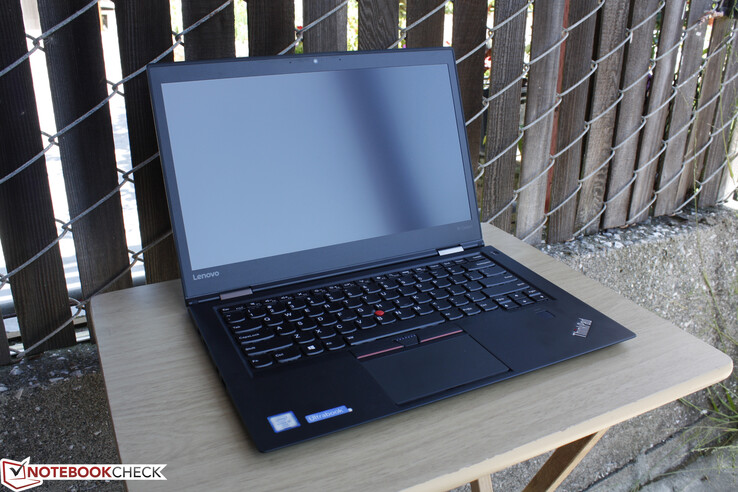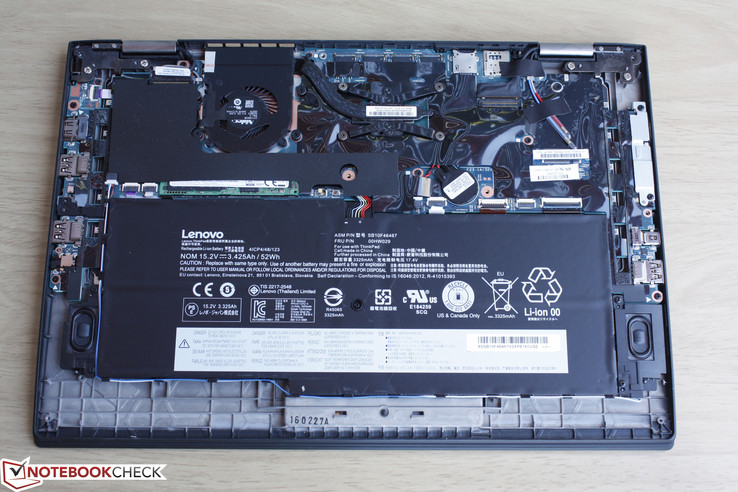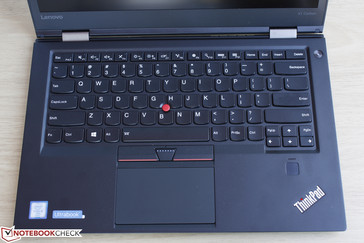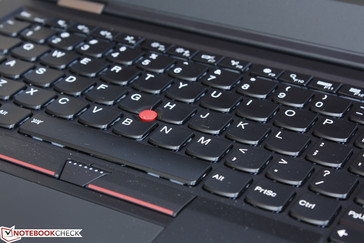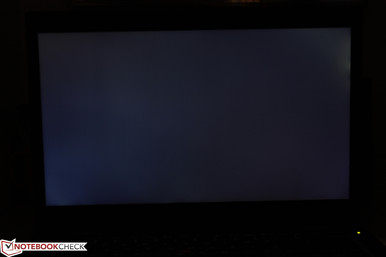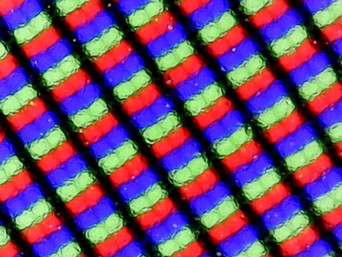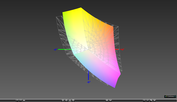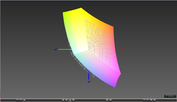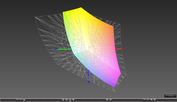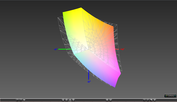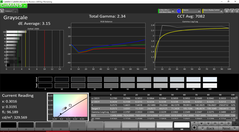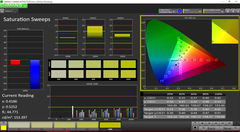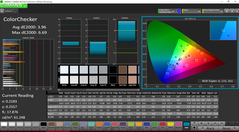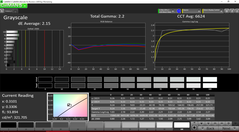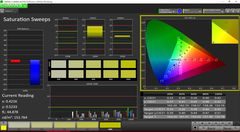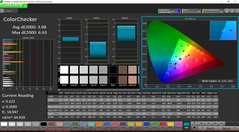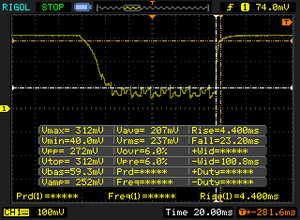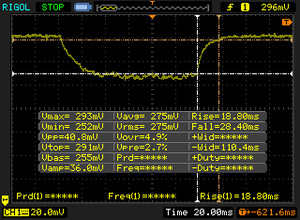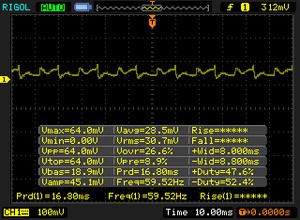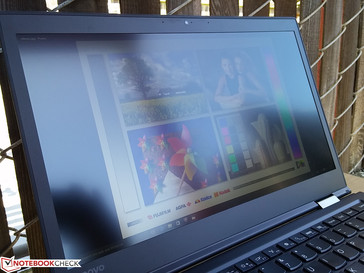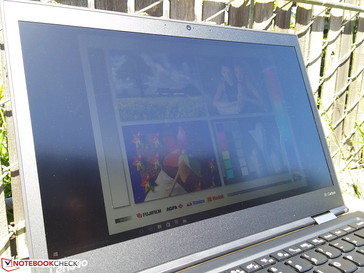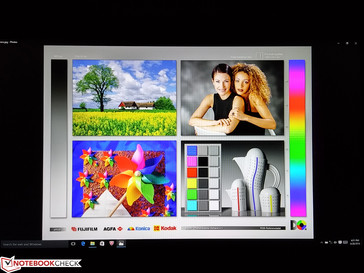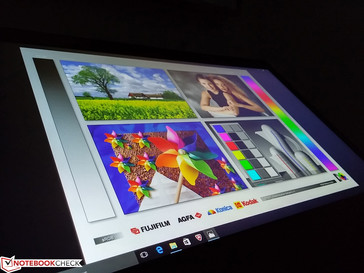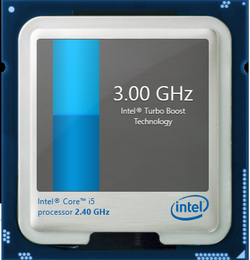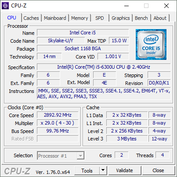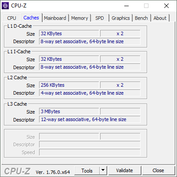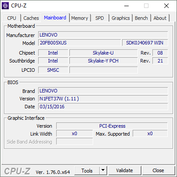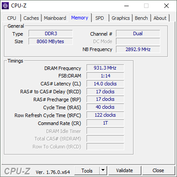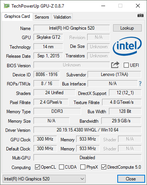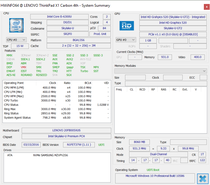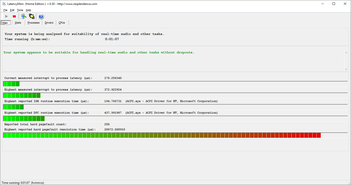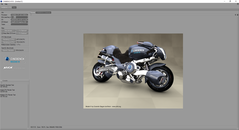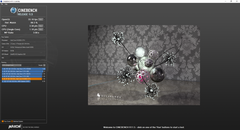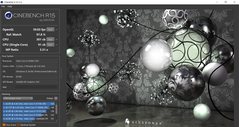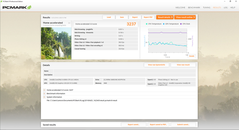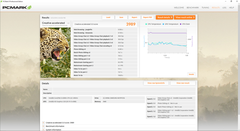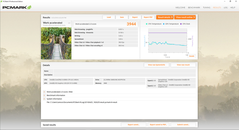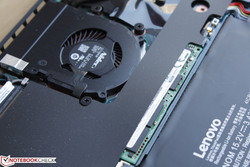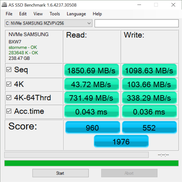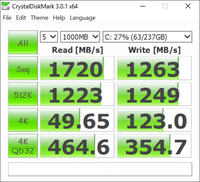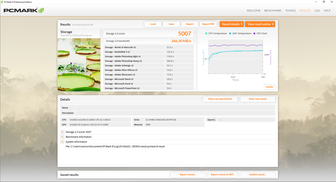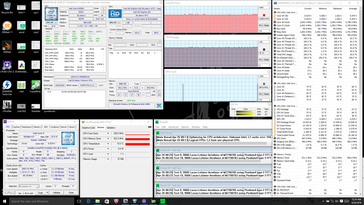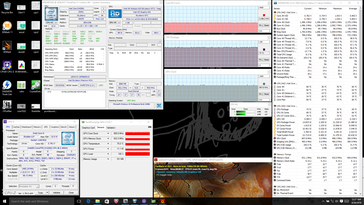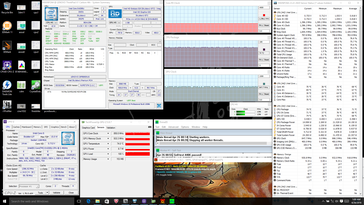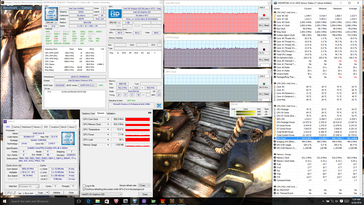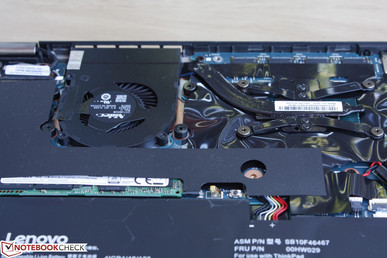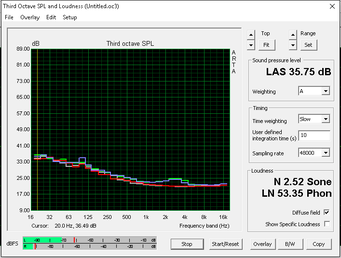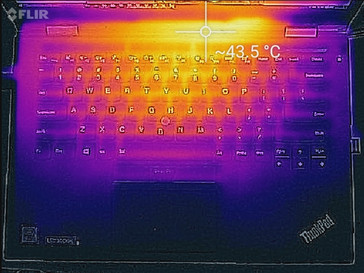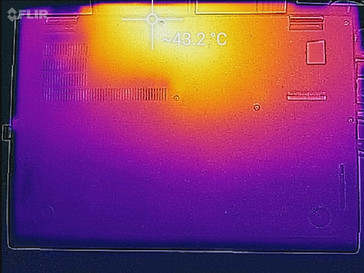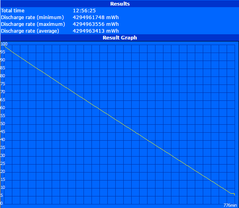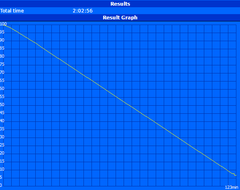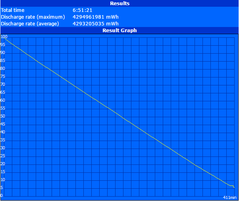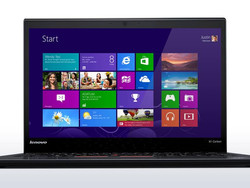Lenovo ThinkPad X1 Carbon 20FB-005XUS Notebook Review
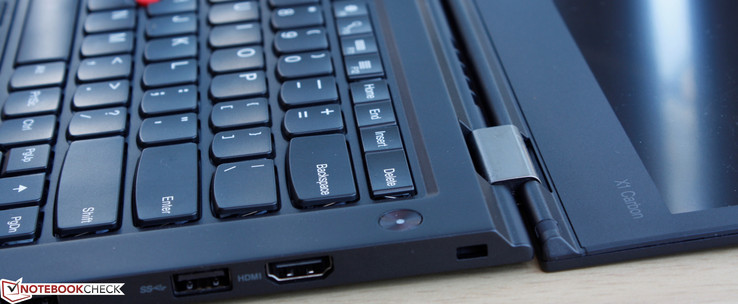
Now in its fourth generation, the super-thin ThinkPad X1 Carbon has proven to be a popular compromise between the more feature-heavy but thicker ThinkPad T460s and a thinner but more barebones Ultrabook. The X1 Carbon is still one of the few Ultrabooks with integrated WWAN, which should appeal to travelers and business users.
We recently published on the higher-end SKU with the Core i7-6500U CPU and WQHD (2560 x 1440) resolution panel. Our latest test unit is one configuration down with a Core i5-6300U CPU and FHD (1920 x 1080) resolution panel. All other factors remain equal save for the slight change in the NVMe Samsung SSD models between our two units. What drawbacks and benefits are there in this less expensive Core i5 FHD SKU compared to the Core i7 WQHD SKU?
We recommend checking out our previous review on the fourth generation ThinkPad X1 Carbon for more pictures and details on the chassis, input devices, and other hardware features.
Case
The latest X1 Carbon is thinner than the outgoing generation (16.5 mm vs. 19 mm), but is actually slightly bigger in length and width. The magnesium and Carbon fiber matte chassis still looks fantastic and professional as any ThinkPad should. Though not a unibody construction, its base and lid are both very rigid and resistant to twists and depressions. That's not to say it's impossible to twist and bend the notebook, however, but any warping is minimal with no creaking when applying moderate force. From this perspective, the notebook is a tad weaker than the latest Dell XPS 13 9350. We can observe no manufacturing defects or gaps between materials just like on our original WQHD test unit.
The thinner size means less protection against bumps and the elements compared to the thicker T460 alternative. Despite this, the X1 Carbon still meets eight of the nine MIL-SPEC requirements and feels noticeably sturdier than full-fledged consumer Ultrabooks like the Zenbook. The hinges are just tight enough to prevent the lid from teetering when typing.
Connectivity
Available interfaces are relatively plentiful considering the size of the notebook including 3x USB 3.0, dual video-out ports, MicroSD slot, and Micro-SIM slot. The proprietary OneLink+ port provides even more options for the notebook with the optional OneLink+ Dock. This port, however, now feels extraneous as we would have preferred the more universal USB Type-C port with integrated Thunderbolt 3 instead. Dell, for example, is already moving in this direction with its latest XPS and Latitude series of notebooks.
Communication
WLAN is provided by the dual-band Intel 8260 M.2 module for up to 802.11ac connectivity with integrated Bluetooth and WiDi. We experienced no recurring connection drops or other issues with our Linksys AC2600 test router.
Micro-SIM is supported for WWAN 4G LTE-A connectivity and GPS.
Accessories
Included extras outside of the power adapter are limited to a setup guide. Proprietary extras exist to make use of the OneLink+ dock for VGA, Gigabit Ethernet, and others.
Maintenance
The bottom panel is relatively easy to remove with a simple Philips screwdriver. Loosening the nine screws underneath will reveal core motherboard components most of which are covered by a protective layer of plastic. Upgradeability is limited to the M.2 2230 WLAN module, M.2 2280 M.2 SSD, and BIOS battery. Our test unit carries the exact same battery capacity as the WQHD SKU despite having a lower resolution panel.
Warranty
The standard one-year warranty applies with plenty of options as expected from Lenovo. Users can extend coverage to up to five years with accidental damage protection.
Input Devices
Keyboard
The spill-resistant chiclet keyboard is one of the best for its size class. This is largely due to the fact that key travel is so much deeper than on most other Ultrabooks, so each press has weight to it with firm feedback and almost no clatter. The slightly concave keys are raised visibly higher from its base compared to most other Ultrabooks for this reason. The Enter and Space keys have just the right level of feedback and clatter and we can find no major complaints in terms of comfort.
Touchpad
The touchpad (10 x 5.8 cm) and its integrated mouse keys are also very good in terms of gliding, feedback, and precision. Dedicated mouse keys and a TrackPoint are provided as well, which aren't always the case for smaller notebooks. The feedback of the keys here are a bit of the soft side, so that may take users a bit of time to become accustomed to.
Display
The matte 1080p screen provides a clean and very crisp picture without the need for any glossy overlays. Similar B140HAN01.x panels can also be found on a number of 14-inch notebooks including the Acer TravelMate P645, Gigabyte P34G, and some Clevo barebones. When compared to the WQHD panel on our previous ThinkPad X1 Carbon test unit, this FHD panel is brighter while keeping contrast levels roughly the same.
Minor backlight bleeding is present on our test unit near the top right and bottom left corners. The uneven lighting is noticeable only when on maximum brightness against a dark picture, so it can be largely ignored during everyday use.
| |||||||||||||||||||||||||
Brightness Distribution: 89 %
Center on Battery: 321.7 cd/m²
Contrast: 1094:1 (Black: 0.294 cd/m²)
ΔE ColorChecker Calman: 3.96 | ∀{0.5-29.43 Ø4.78}
ΔE Greyscale Calman: 3.15 | ∀{0.09-98 Ø5}
82.7% sRGB (Argyll 1.6.3 3D)
53.8% AdobeRGB 1998 (Argyll 1.6.3 3D)
60.3% AdobeRGB 1998 (Argyll 3D)
83.1% sRGB (Argyll 3D)
58.9% Display P3 (Argyll 3D)
Gamma: 2.34
CCT: 7082 K
| Lenovo ThinkPad X1 Carbon 20FB-005XUS 14", 1920x1080 | Lenovo ThinkPad X1 Carbon 20FB003RGE 14", 2560x1440 | Lenovo ThinkPad T460s-20FA003GGE 14", 2560x1440 | Lenovo Thinkpad X1 Yoga 20FQ-000QUS 14", 2560x1440 | HP ProBook 440 G3 14", 1920x1080 | |
|---|---|---|---|---|---|
| Display | 13% | 17% | 16% | -31% | |
| Display P3 Coverage (%) | 58.9 | 66.7 13% | 68.7 17% | 68.1 16% | 39.6 -33% |
| sRGB Coverage (%) | 83.1 | 94.7 14% | 98.1 18% | 97.2 17% | 59.1 -29% |
| AdobeRGB 1998 Coverage (%) | 60.3 | 68.4 13% | 70.4 17% | 70.2 16% | 40.94 -32% |
| Response Times | 10% | 10% | 5% | 2% | |
| Response Time Grey 50% / Grey 80% * (ms) | 47.2 ? | 44 ? 7% | 35.6 ? 25% | 38 ? 19% | 46 ? 3% |
| Response Time Black / White * (ms) | 27.6 ? | 24 ? 13% | 29.2 ? -6% | 30.4 ? -10% | 27.6 ? -0% |
| PWM Frequency (Hz) | 220 ? | 220 ? | 219 ? | ||
| Screen | 2% | -15% | -27% | -62% | |
| Brightness middle (cd/m²) | 321.7 | 272 -15% | 257 -20% | 284.7 -12% | 246 -24% |
| Brightness (cd/m²) | 301 | 268 -11% | 248 -18% | 272 -10% | 215 -29% |
| Brightness Distribution (%) | 89 | 95 7% | 94 6% | 89 0% | 84 -6% |
| Black Level * (cd/m²) | 0.294 | 0.32 -9% | 0.26 12% | 0.383 -30% | 0.5 -70% |
| Contrast (:1) | 1094 | 850 -22% | 988 -10% | 743 -32% | 492 -55% |
| Colorchecker dE 2000 * | 3.96 | 2.61 34% | 4.59 -16% | 5.24 -32% | 8.6 -117% |
| Colorchecker dE 2000 max. * | 6.69 | 6.43 4% | 9.72 -45% | 11.22 -68% | |
| Greyscale dE 2000 * | 3.15 | 3.31 -5% | 6.38 -103% | 7.32 -132% | 9.36 -197% |
| Gamma | 2.34 94% | 2.35 94% | 2.51 88% | 2.22 99% | 2.39 92% |
| CCT | 7082 92% | 6360 102% | 6238 104% | 6277 104% | 11226 58% |
| Color Space (Percent of AdobeRGB 1998) (%) | 53.8 | 63 17% | 65 21% | 70.17 30% | 37.8 -30% |
| Color Space (Percent of sRGB) (%) | 82.7 | 95 15% | 98 19% | 94.68 14% | 59.1 -29% |
| Total Average (Program / Settings) | 8% /
5% | 4% /
-6% | -2% /
-14% | -30% /
-46% |
* ... smaller is better
Color coverage is roughly 83 percent and 54 percent of the sRGB and AdobeRGB standards, respectively, to indicate a high-end panel in use. This is slightly narrower than the gamut of the ThinkPad X1 Carbon SKU with the higher resolution WQHD panel, so users opting in on this FHD SKU will lose out on both pixels and color accuracy. Colors are still significantly better than less expensive TN panels such as the one found on the HP ProBook 440 G3.
Measurements with an X-Rite spectrophotometer reveal that grayscale and color accuracy are both already very good out-of-the-box. A quick calibration will improve the display even further, but color accuracy still decreases with increasing saturation levels due to imperfect sRGB coverage.
Display Response Times
| ↔ Response Time Black to White | ||
|---|---|---|
| 27.6 ms ... rise ↗ and fall ↘ combined | ↗ 4.4 ms rise | |
| ↘ 23.2 ms fall | ||
| The screen shows relatively slow response rates in our tests and may be too slow for gamers. In comparison, all tested devices range from 0.1 (minimum) to 240 (maximum) ms. » 69 % of all devices are better. This means that the measured response time is worse than the average of all tested devices (20.2 ms). | ||
| ↔ Response Time 50% Grey to 80% Grey | ||
| 47.2 ms ... rise ↗ and fall ↘ combined | ↗ 18.8 ms rise | |
| ↘ 28.4 ms fall | ||
| The screen shows slow response rates in our tests and will be unsatisfactory for gamers. In comparison, all tested devices range from 0.165 (minimum) to 636 (maximum) ms. » 81 % of all devices are better. This means that the measured response time is worse than the average of all tested devices (31.6 ms). | ||
Screen Flickering / PWM (Pulse-Width Modulation)
| Screen flickering / PWM not detected | |||
In comparison: 53 % of all tested devices do not use PWM to dim the display. If PWM was detected, an average of 8111 (minimum: 5 - maximum: 343500) Hz was measured. | |||
Outdoor usability is average under shade and poor under direct sunlight as the backlight is not bright enough to overcome the intense ambient light. The matte panel helps tremendously in reducing glare and both the 180-degree hinges and underlying IPS panel definitely come in handy if sunlight cannot be avoided.
Viewing angles are excellent with no yellowing and just minor contrast and brightness dips at extreme angles.
Performance
Unlike the dual-core 2.5 GHz Core i7-6500U in our previous X1 Carbon SKU, our current SKU carries the slightly weaker dual-core 2.4 GHz Core i5-6300U with Turbo Boost up to 3 GHz and 2.9 GHz for single-core and multi-core processes, respectively. Both models carry the same HD Graphics 520 GPU, but graphics performances will not be the same since GPU power will depend on the CPU it is paired with. Thus, the Core i7-6500U configuration should come out slightly ahead in both CPU and GPU benchmarks.
8 GB LPDDR3 RAM is installed with no DDR4 option. Memory is non-expandable and is soldered onto the board in dual-channel mode.
Processor
The ULV processor performs in the same ballpark as other ULV CPUs in the Skylake family. Overall performance is not significantly better than even older processors like the i5-4200U according to CineBench benchmarks. The single-threaded performance of our Lenovo configuration in particular is slow at just 91 points even after multiple re-runs for a better score. The CPU appears to be unable to maintain its maximum 3.0 GHz Turbo Boost and will instead run at 2.9 GHz for almost the entire benchmarking duration.
See our dedicated CPU page on the Core i5-6300U for more comparisons and technical information.
| Cinebench R15 | |
| CPU Single 64Bit (sort by value) | |
| Lenovo ThinkPad X1 Carbon 20FB-005XUS | |
| Lenovo ThinkPad X1 Carbon 20FB003RGE | |
| Asus GL552VW-DK725T | |
| HP ProBook 430 G3 P4N86EA | |
| Lenovo IdeaPad Z40-59422614 | |
| Toshiba Tecra A50-C1510W10 | |
| CPU Multi 64Bit (sort by value) | |
| Lenovo ThinkPad X1 Carbon 20FB-005XUS | |
| Lenovo ThinkPad X1 Carbon 20FB003RGE | |
| Asus GL552VW-DK725T | |
| HP ProBook 430 G3 P4N86EA | |
| Lenovo IdeaPad Z40-59422614 | |
| Toshiba Tecra A50-C1510W10 | |
| Cinebench R11.5 | |
| CPU Single 64Bit (sort by value) | |
| Lenovo ThinkPad X1 Carbon 20FB-005XUS | |
| Lenovo ThinkPad X1 Carbon 20FB003RGE | |
| Asus GL552VW-DK725T | |
| HP ProBook 430 G3 P4N86EA | |
| Lenovo IdeaPad Z40-59422614 | |
| Toshiba Tecra A50-C1510W10 | |
| CPU Multi 64Bit (sort by value) | |
| Lenovo ThinkPad X1 Carbon 20FB-005XUS | |
| Lenovo ThinkPad X1 Carbon 20FB003RGE | |
| Asus GL552VW-DK725T | |
| HP ProBook 430 G3 P4N86EA | |
| Lenovo IdeaPad Z40-59422614 | |
| Toshiba Tecra A50-C1510W10 | |
| Cinebench R10 | |
| Rendering Multiple CPUs 32Bit (sort by value) | |
| Lenovo ThinkPad X1 Carbon 20FB-005XUS | |
| Lenovo ThinkPad X1 Carbon 20FB003RGE | |
| Asus GL552VW-DK725T | |
| HP ProBook 430 G3 P4N86EA | |
| Lenovo IdeaPad Z40-59422614 | |
| Toshiba Tecra A50-C1510W10 | |
| Rendering Single 32Bit (sort by value) | |
| Lenovo ThinkPad X1 Carbon 20FB-005XUS | |
| Lenovo ThinkPad X1 Carbon 20FB003RGE | |
| Asus GL552VW-DK725T | |
| HP ProBook 430 G3 P4N86EA | |
| Lenovo IdeaPad Z40-59422614 | |
| Toshiba Tecra A50-C1510W10 | |
| wPrime 2.10 - 1024m (sort by value) | |
| Lenovo ThinkPad X1 Carbon 20FB-005XUS | |
| Asus GL552VW-DK725T | |
| HP ProBook 430 G3 P4N86EA | |
| Lenovo IdeaPad Z40-59422614 | |
| Toshiba Tecra A50-C1510W10 | |
| Super Pi Mod 1.5 XS 32M - 32M (sort by value) | |
| Lenovo ThinkPad X1 Carbon 20FB-005XUS | |
| Lenovo ThinkPad X1 Carbon 20FB003RGE | |
| Asus GL552VW-DK725T | |
| HP ProBook 430 G3 P4N86EA | |
| Lenovo IdeaPad Z40-59422614 | |
| Toshiba Tecra A50-C1510W10 | |
| 3DMark 11 - 1280x720 Performance Physics (sort by value) | |
| Lenovo ThinkPad X1 Carbon 20FB-005XUS | |
| Lenovo ThinkPad X1 Carbon 20FB003RGE | |
| Asus GL552VW-DK725T | |
| HP ProBook 430 G3 P4N86EA | |
| Lenovo IdeaPad Z40-59422614 | |
| Toshiba Tecra A50-C1510W10 | |
* ... smaller is better
System Performance
PCMark 8 ranks our X1 Carbon in the same ballpark as competing 14-inch notebooks with ULV Skylake processors. Final scores are consistently below our previous X1 Carbon model by slight margins.
We experienced no hardware or software issues specific to our test unit.
| PCMark 8 Home Score Accelerated v2 | 3237 points | |
| PCMark 8 Creative Score Accelerated v2 | 3989 points | |
| PCMark 8 Work Score Accelerated v2 | 3944 points | |
Help | ||
Storage Devices
Only a single NVMe M.2 2280 slot is available for internal storage. Performance easily outclasses any SATA III solution including those in RAID 0 with sequential read and write rates reaching four-digit numbers. While the 512 GB Samsung SM951 in the ThinkPad X1 Yoga is a bit faster than the 256 GB Samsung SM951 in our ThinkPad X1 Carbon test unit, users will likely not be able to notice any speed discrepancies during use.
See our growing table of HDDs and SSDs for more benchmarks and comparisons.
| Lenovo ThinkPad X1 Carbon 20FB-005XUS HD Graphics 520, 6300U, Samsung SM951 MZVPV256 m.2 | HP EliteBook 840 G3 T8X41EA HD Graphics 520, 6600U, Samsung SSD 850 EVO 500GB | Lenovo ThinkPad T460s-20FA003GGE HD Graphics 520, 6600U, Samsung SSD SM951a 512GB M.2 PCIe 3.0 x4 NVMe (MZVKV512) | Lenovo Thinkpad X1 Yoga 20FQ-000QUS HD Graphics 520, 6500U, Samsung SSD PM871 MZNLN512HCJH | Dell Latitude 14 7000 Series E7470 HD Graphics 520, 6600U, Samsung SSD PM851 M.2 2280 256GB | |
|---|---|---|---|---|---|
| AS SSD | -31% | 20% | -45% | -57% | |
| Copy Game MB/s (MB/s) | 598 | 791 32% | 236.4 -60% | ||
| Copy Program MB/s (MB/s) | 354.9 | 421.9 19% | 196.5 -45% | ||
| Copy ISO MB/s (MB/s) | 709 | 1135 60% | 258.4 -64% | ||
| Score Total (Points) | 1976 | 1125 -43% | 2439 23% | 1068 -46% | 913 -54% |
| Score Write (Points) | 552 | 436 -21% | 621 13% | 382 -31% | 283 -49% |
| Score Read (Points) | 960 | 447 -53% | 1218 27% | 449 -53% | 417 -57% |
| Access Time Write * (ms) | 0.036 | 0.034 6% | 0.033 8% | 0.046 -28% | 0.04 -11% |
| Access Time Read * (ms) | 0.043 | 0.053 -23% | 0.041 5% | 0.058 -35% | 0.113 -163% |
| 4K-64 Write (MB/s) | 338.3 | 290.8 -14% | 366 8% | 261.9 -23% | 170 -50% |
| 4K-64 Read (MB/s) | 731 | 355.9 -51% | 968 32% | 369.1 -50% | 336.1 -54% |
| 4K Write (MB/s) | 103.7 | 98.6 -5% | 114.4 10% | 75.7 -27% | 85.1 -18% |
| 4K Read (MB/s) | 43.72 | 41.29 -6% | 45.41 4% | 30.35 -31% | 30.91 -29% |
| Seq Write (MB/s) | 1099 | 464 -58% | 1407 28% | 447.5 -59% | 283.7 -74% |
| Seq Read (MB/s) | 1851 | 498.6 -73% | 2039 10% | 490.1 -74% | 495.5 -73% |
* ... smaller is better
GPU Performance
The integrated HD Graphics 520 is only about 10 to 15 percent ahead of the HD Graphics 515 in the fanless MacBook 12 according to 3DMark Cloud Gate and Fire Strike. Even the very low-end Nvidia 920M GPU is roughly 30 to 40 percent faster than our Lenovo, so this system is clearly not made for 3D gaming outside of the usual top-down MOBA titles and other less intensive titles.
See our dedicated GPU page on the HD Graphics 520 for more benchmarks and comparisons.
| 3DMark 11 Performance | 1396 points | |
| 3DMark Ice Storm Standard Score | 57713 points | |
| 3DMark Cloud Gate Standard Score | 5659 points | |
| 3DMark Fire Strike Score | 772 points | |
Help | ||
| low | med. | high | ultra | |
|---|---|---|---|---|
| BioShock Infinite (2013) | 47.6 | 27.1 | 24.8 | 6.6 |
Stress Test
We stress the notebook with Prime95 and FurMark to observe for any throttling or system stability issues. The notebook is able to maintain a clock rate of 2.7 GHz (or 200 MHz below its rated maximum) when running Prime95 with core temperature averaging 75 C. Running both Prime95 and FurMark will throttle the CPU to just 1.4 GHz in what appears to be an attempt to maintain core temperature in the mid 70 C range. The system performs much better under Unigine Heaven load with the CPU and GPU running above their respective base clock rates and at a stable temperature of about 70 C.
Running on battery power will not throttle the CPU or GPU, so users can use the full power of the notebook even if not connected to mains. A 3DMark 11 run on batteries results in Physics and Graphics scores of 4159 points and 1256 points, respectively, compared to 4173 points and 1227 points when connected to an outlet.
| CPU Clock (GHz) | GPU Clock (MHz) | Average CPU Temperature (C) | |
Prime95 Stress |
2.7 | -- | ~75 |
FurMark Stress |
-- | 900 | ~75 |
Prime95 + FurMark Stress |
1.4 | 850 | ~74 |
Unigine Heaven Stress |
2.6+ | 950 | ~70 |
Emissions
System Noise
The thin and short heat pipe with a barely active system fan are apparently sufficient for the lone ULV Intel CPU. The system runs silently when running low-medium loads or even when gaming for the first few minutes before the fan decides to pick up speed. At worst, fan noise will be as high as 36 dB(A) under unrealistically stressful conditions. Extended gaming will cause fan noise to hover pretty close to its maximum at around 35 dB(A). Perhaps unsurprisingly, fan noise and behavior are almost identical to that of the Lenovo ThinkPad X1 Yoga.
| Lenovo ThinkPad X1 Carbon 20FB-005XUS HD Graphics 520, 6300U, Samsung SM951 MZVPV256 m.2 | Lenovo ThinkPad X1 Carbon 20FB003RGE HD Graphics 520, 6500U, Samsung SSD PM871 MZNLN256HCHP | HP EliteBook 840 G3 T9X59ET#ABD HD Graphics 520, 6500U, Samsung SSD PM851 256 GB MZNTE256HMHP | Lenovo ThinkPad T460s-20FA003GGE HD Graphics 520, 6600U, Samsung SSD SM951a 512GB M.2 PCIe 3.0 x4 NVMe (MZVKV512) | Lenovo Thinkpad X1 Yoga 20FQ-000QUS HD Graphics 520, 6500U, Samsung SSD PM871 MZNLN512HCJH | Dell Latitude 14 7000 Series E7470 HD Graphics 520, 6600U, Samsung SSD PM851 M.2 2280 256GB | |
|---|---|---|---|---|---|---|
| Noise | -2% | -9% | -1% | 0% | -2% | |
| off / environment * (dB) | 28.8 | 29.1 -1% | 31.2 -8% | 29.2 -1% | 28.8 -0% | 31.2 -8% |
| Idle Minimum * (dB) | 28.8 | 29.1 -1% | 31.2 -8% | 29.2 -1% | 28.8 -0% | 31.2 -8% |
| Idle Average * (dB) | 28.9 | 29.1 -1% | 32.1 -11% | 29.2 -1% | 28.8 -0% | 31.2 -8% |
| Idle Maximum * (dB) | 28.9 | 29.1 -1% | 33.1 -15% | 29.2 -1% | 28.8 -0% | 31.2 -8% |
| Load Average * (dB) | 35 | 35.6 -2% | 36.2 -3% | 33.7 4% | 35.2 -1% | 31.9 9% |
| Load Maximum * (dB) | 35.8 | 38.1 -6% | 37.8 -6% | 38.5 -8% | 35.2 2% | 31.9 11% |
* ... smaller is better
Noise level
| Idle |
| 28.8 / 28.9 / 28.9 dB(A) |
| Load |
| 35 / 35.8 dB(A) |
 | ||
30 dB silent 40 dB(A) audible 50 dB(A) loud |
||
min: | ||
Temperature
The small cooling system means a more concentrated point heat source. The warm spot near the upper center of the notebook is noticeable even when the system is idling. Fortunately, this never becomes uncomfortably warm when surfing the net or gaming.
Very high loads for extended periods can cause surface temperatures to rise as high as 40 C or 43 C on the top and bottom sides, respectively. The palm rests and front half of the notebook in general will always remain comparatively cooler with warmer keys toward the center. The similarly sized ThinkPad X1 Yoga can become even warmer at almost 50 C under the same extreme conditions.
(±) The maximum temperature on the upper side is 40 °C / 104 F, compared to the average of 34.3 °C / 94 F, ranging from 21.2 to 62.5 °C for the class Office.
(±) The bottom heats up to a maximum of 42.8 °C / 109 F, compared to the average of 36.8 °C / 98 F
(+) In idle usage, the average temperature for the upper side is 24.2 °C / 76 F, compared to the device average of 29.5 °C / 85 F.
(+) The palmrests and touchpad are cooler than skin temperature with a maximum of 24.6 °C / 76.3 F and are therefore cool to the touch.
(+) The average temperature of the palmrest area of similar devices was 27.6 °C / 81.7 F (+3 °C / 5.4 F).
Speakers
The 1 W stereo speakers are strong but lacking in bass reproduction as revealed by our microphone measurements. This makes the internal speakers less ideal for multimedia use such as video and music playback. External solutions through HDMI or the 3.5 mm audio port are recommended for extended media use.
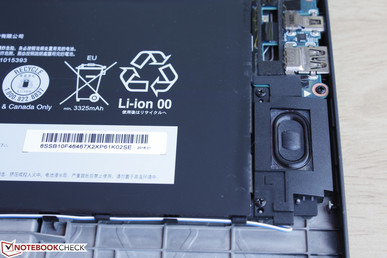
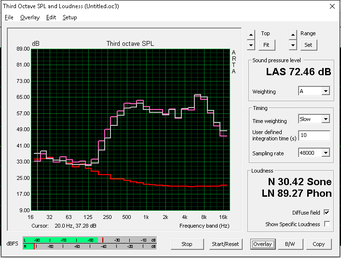
Energy Management
Power Consumption
Power demands are generally low at just under 10 W when idling on the highest brightness setting. Gaming loads will bump the system to around 24 W while Prime95+FurMark will bump it even higher to just over 30 W. The small power adapter itself (10.5 4.5 x 3 cm) is rated for 65 W and 20 V, so Lenovo is playing it very safe with the large overhead. Similarly sized competitors with ULV Skylake processors also clock in roughly 30 W when under stress.
| Lenovo ThinkPad X1 Carbon 20FB-005XUS HD Graphics 520, 6300U, Samsung SM951 MZVPV256 m.2 | Lenovo ThinkPad X1 Carbon 20FB003RGE HD Graphics 520, 6500U, Samsung SSD PM871 MZNLN256HCHP | HP EliteBook 840 G3 T9X59ET#ABD HD Graphics 520, 6500U, Samsung SSD PM851 256 GB MZNTE256HMHP | Lenovo ThinkPad T460s-20FA003GGE HD Graphics 520, 6600U, Samsung SSD SM951a 512GB M.2 PCIe 3.0 x4 NVMe (MZVKV512) | Lenovo Thinkpad X1 Yoga 20FQ-000QUS HD Graphics 520, 6500U, Samsung SSD PM871 MZNLN512HCJH | Dell Latitude 14 7000 Series E7470 HD Graphics 520, 6600U, Samsung SSD PM851 M.2 2280 256GB | |
|---|---|---|---|---|---|---|
| Power Consumption | 4% | 15% | -2% | -19% | -2% | |
| Idle Minimum * (Watt) | 7.6 | 3.8 50% | 3.8 50% | 3.8 50% | 6.82 10% | 5.1 33% |
| Idle Average * (Watt) | 9 | 7.1 21% | 6.3 30% | 7.1 21% | 8.21 9% | 8.5 6% |
| Idle Maximum * (Watt) | 9.6 | 7.7 20% | 6.8 29% | 7.8 19% | 17.55 -83% | 10.1 -5% |
| Load Average * (Watt) | 24.5 | 30.2 -23% | 34.4 -40% | 36.3 -48% | 28.81 -18% | 35.2 -44% |
| Load Maximum * (Watt) | 30.3 | 44.7 -48% | 28.3 7% | 46 -52% | 34.07 -12% | 31 -2% |
* ... smaller is better
| Off / Standby | |
| Idle | |
| Load |
|
Key:
min: | |
Battery Life
Runtimes from the non-removable 52 Wh battery pack are above average. Users can expect just under seven hours of constant WLAN use at a brightness setting of 150 nits (75 percent). This is over an hour longer than the ThinkPad T460s under the same conditions, but still behind the HP EliteBook 840 G3.
Charging from near empty to full with the included charger will take roughly four to five hours. The charge is very slow as typical charge times normally come in at under three hours.
| Lenovo ThinkPad X1 Carbon 20FB-005XUS 52 Wh | Lenovo ThinkPad X1 Carbon 20FB003RGE 52 Wh | HP EliteBook 840 G3 T9X59ET#ABD 46 Wh | Lenovo ThinkPad T460s-20FA003GGE 49 Wh | Lenovo Thinkpad X1 Yoga 20FQ-000QUS 52 Wh | |
|---|---|---|---|---|---|
| Battery runtime | 5% | 19% | -20% | 0% | |
| Reader / Idle (h) | 12.9 | 15.7 22% | 17 32% | 13.9 8% | 15.4 19% |
| WiFi v1.3 (h) | 6.9 | 7.2 4% | 7.6 10% | 5.7 -17% | 5.9 -14% |
| Load (h) | 2.1 | 1.9 -10% | 2.4 14% | 1 -52% | 2 -5% |
Pros
Cons
Verdict
With strong alternatives available like the MacBook Air or XPS 13, the pressure has been hard on Lenovo to keep the ThinkPad X1 Carbon series going strong. The latest model feels better than ever as detailed in our previous review of the unit and its WWAN options will be sure to attract a lot of interested buyers.
Does the Core i5 FHD configuration offer noticeably longer runtimes and lower temperatures than the Core i7 WQHD configuration? Battery runtimes are not significantly different than the pricier SKU and while surface temperatures are a bit lower, it will only be a couple of degrees at best. These minor differences between the two SKUs mean that users can opt in on the costlier model for its faster performance, more accurate colors, and denser display without sacrificing much in the way of battery life.
The performance of the Core i5 is lower than expected, in particular in single-core operations. Perhaps the most noteworthy difference is that this FHD configuration does not utilize PWM for brightness control in contrast to the WQHD configuration. Thus, users who are sensitive to screen flickering may prefer the FHD model in lieu of a faster processor.
Lenovo ThinkPad X1 Carbon 20FB-005XUS
- 05/13/2016 v5.1 (old)
Allen Ngo




